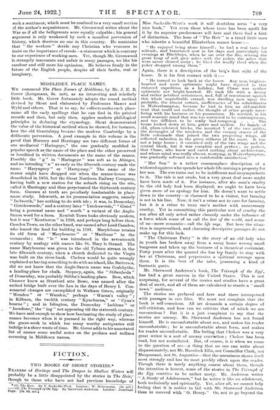MIDDLESEX PLACE NAMES.
WE commend The Place Names of Middlesex, by Mr. J. E. B. Gover (Longmans, 5s. net), as an interesting and scholarly little book. Mr. Gover fortunately adopts the sound method devised by Skeat and elaborated by Professors Mawer and Wyld and others. That is to say, he collects under each place- name all the early spellings that he can find in the printed records and then, but only then, applies modern philological principles in deducing the etymology. Skeat demonstrated the value of the historical method when he showed, for instance, how the old Grantabryg became the modern Cambridge by a deliberate perversion. A good example in this volume is the proof that Hornsey and Harringay are two different forms of one mediaeval " Haringeye," the one gradually modified in popular speech as the name of the place and the other preserved or fossilized in written documents as the name of the manor. Possibly the " g " in " Haringeye " was soft as in Abinger, and an intruding " n " as early as the fifteenth century made the name " Haryngney " or " Harnyssay." The name of the manor might have dropped out when the manor-house was demolished in 1870, but the Great Northern Railway Company, having built a new station for the suburb rising on the site, called it Harringay and thus perpetuated the thirteenth century form. Guesses at truth are peculiarly inadmissible in place- name study. Isleworth, as its pronunciation suggests, namely " Izelworth," has nothing to do with isle ; it was, in Domesday, " Gistelesworde," and a century later " Ystelesworde," " Gistel " being a personal name and " worth " a variant of the Anglo- Saxon word for a farm. Kentish Town looks obviously modern, but it was " Kentisst,on " in 1208, and perhaps long before then. Camden Town, on the other hand, was named after Lord Camden, who leased the land for building in 1791. Marylebone retains its old form of " Marybourne " or " Maribone " in the vernacular ; the " le " was introduced in the seventeenth century by analogy with names like St. Mary le Strand. The name Marybourne was given to the old Tyburn stream in the late fifteenth century, when a church dedicated to the Virgin was built on the river-bank. Chelsea would be quite wrongly explained as having something to do with an island, like Battersea, did we not know that the Anglo-Saxon name was Cealchythe, a landing-place for chalk. Stepney, again, the " Stibenheda " of Domesday, was probably Stibba's landing-place. Bow, which Chaucer knew as Stratford atte Bowe, was named after the arched bridge built over the Lea in the days of Henry I. Con- sonantal changes are exemplified in Walham Green, originally " Wenden " or " Wanden," perhaps " Waena's valley " ; in Kilburn, the twelfth century " Kynebuma," or " Cyna's bourne " ; and in Islington, the Domesday " Iseldone " or " Isendone,'' the " ing " not appearing till the sixteenth century. We have said enough to show how fascinating the study of place- names becomes when it is pursued in the right way, whereas the guess-work in which too many worthy antiquaries still indulge is a sheer waste of time. Mr. Gover adds to his annotated list of names some useful notes on the prefixes and suffixes occurring in Middlesex names.


































 Previous page
Previous page